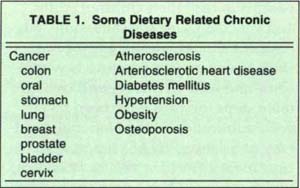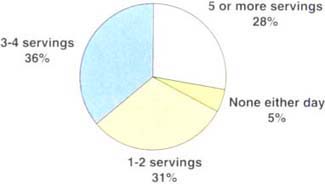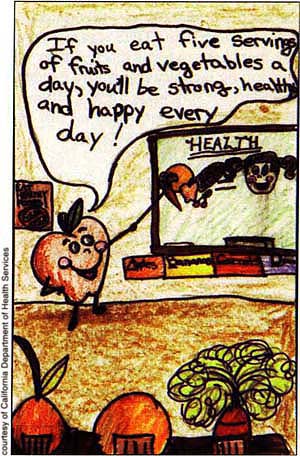All Issues
Based on recent developments, public health, agriculture can forge new partnerskips
Publication Information
California Agriculture 48(1):36-40.
Published January 01, 1994
PDF | Citation | Permissions
Abstract
There has been a close relationship between food production and public health interests since antiquity. A colorful subchapter of human history involves the myriad epidemics and diseases transmitted via food. Today — despite marked improvements in food safety —food continues to be a significant source of ill health, and food safety continues to be a prominent public concern, although the reasons have changed. Current food-related health problems in the U.S. and other developed nations are mostly due to people eating too much fat and sugar, and too few fruits and vegetables. Recent developments in California, and nationally, provide opportunities for agriculture and public health entities to work together in new ways to increase consumption of fruits and vegetables and to increase the public's confidence in the safety of these products.
Full text
Today's large and highly complex food production systems challenge those charged with overseeing the safety of food. Instead of fear about botulism, cholera or typhoid fever, as was the case earlier this century, today's most often voiced concerns focus on trace residues of pesticides, hormones, antibiotics and other chemicals used to improve agricultural productivity. In addition, new foodborne microbial pathogens have been identified and add to an already long list of foodborne infectious agents.
Food-related concerns today raise questions which stretch, and often go beyond, the bounds of scientific data, especially with regards to potential long-term effects of ingesting trace chemical residues in foods or the exact mechanisms by which certain foods may increase or decrease the risk of cancer and some other chronic diseases. To address public concerns about trace chemical contaminants and to get the public to eat more healthful foods — more fruits and vegetables — requires that government take new advocacy roles and rethink some of its traditional ways of overseeing food safety.
In this article, I will review some recent developments which illustrate new approaches that government is taking to address concerns about foodborne disease. These approaches portend productive partnerships between public health and agriculture in the years ahead.
Foodborne infectious disease
As a result of widespread food refrigeration and freezing, the use of preservatives, freeze drying and other developments in food processing technology, improved public sanitation and the advent of antibiotics and other modern medical treatments, the toll of foodborne infectious diseases in the United States has markedly diminished in recent decades. In fact, reducing foodborne disease morbidity and mortality is one of the great successes of public health and medicine in the 20th century.
Today, foodborne infectious disease in the United States, as well as in most other developed countries, occurs episodically as isolated cases or small groups of cases (for example, staphylococcal food poisoning from family picnics or salmonellosis from raw milk) or as large epidemics resulting from breakdowns in food processing, followed by distribution of the tainted food over large geographic areas. Today's mass production and rapid distribution of foods allows much less margin for error than in the past.
In foodborne disease outbreaks that are thoroughly investigated, the causative agent is identified in only about a third of the cases. Among these, bacteria account for two-thirds of the outbreaks, about 90% of the illnesses and 96% of the deaths. Chemicals account for about one-fourth of outbreaks, but only 2 to 4% of illnesses, and they rarely cause deaths.
Interestingly, public knowledge and concern about infectious foodborne disease pathogens has been relatively low, even though several of them can cause acute illness with a greater than 50% fatality rate even with intensive medical treatment. Illustrative of this, 80% of food illness-related fatalities in Florida from 1981 through 1992 were due to Vibrio vulnificus.
In contrast to the case with infectious diseases, public concern has been quite high about potential long-term adverse health effects due to trace agrichemical contamination. In some instances, this concern has impeded public health efforts aimed at increasing consumption of fruits and vegetables, which could substantially decrease the burden of diet-related cancer and other chronic diseases that are so prevalent today as a result of the typical high-fat, low-fiber American diet.
Diet-related chronic disease
The toll of diet-related diseases is comparable to the damage caused by tobacco use, yet relatively less is being achieved in reaching national objectives for reducing diet-related chronic diseases than for reducing tobacco consumption. Many of today's top killers are substantially or significantly due to diet (table 1). Approximately one-third of all cancer and about 20% of heart disease could be prevented by reducing dietary fat intake and increasing fruit, vegetable and whole grain consumption. These same dietary changes also could lead to considerable reductions in the occurrence of hypertension, obesity and diabetes among other things.
In California, cancer is the second leading cause of death next to heart disease, accounting for approximately 50,000 deaths in the state each year. Higher consumption of fruits and vegetables has been associated with lower cancer risk in many types of studies — from intercountry comparisons to migration and case control studies. Indeed, 93% of more than 100 human studies that have been done show a cancer-protective effect associated with higher levels of fruit and vegetable consumption.
Both California-specific and national data show that the average American's fruit and vegetable consumption falls below the recommended minimum of five servings of fruits and vegetables per day. For example, the 1989 California Dietary Practices Survey found the average daily intake of fruits and vegetables to be about three servings. In summer, when intake is highest, only 33% of adults ate five servings daily. Seven percent of Californians had eaten no fruits or vegetables on the day before the survey.
California's “5 a Day” campaign
In 1986, the California Department of Health Services (CDHS) was one of nine state and local health departments in the United States that were awarded National Cancer Institute (NCI) grants to develop their capacities for the prevention or early detection of cancer. The CDHS was the only one that chose to focus its efforts on developing technical capacities needed to undertake statewide dietary initiatives for adults. After nearly 2 years of planning and development work, CDHS launched its novel “5 a Day for Better Health” campaign in August, 1988.
The “5 a Day” campaign had a number of distinctive features that contributed to its apparent success. These included a simple, positive, behavior-specific message to eat five servings of fruits and vegetables every day (later adopted as a national recommendation), extensive use of mass media and point-of-purchase messages, and partnership between the state health department and the produce and supermarket industries — something that was truly novel at the time.
By the campaign's end in mid-1991, 15 supermarket chains representing 1,800 stores had signed licensing agreements with CDHS to participate. This was equal to a market penetration of 85% of all grocery stores in California.
Reducing dietary fat and eating more fruits, vegetables and whole grains lowers the risk of cancer and heart disease.
The campaign's use of mass media was substantial, generating 80 million media impressions, including television, radio, newspaper, magazine and other coverage. By highly leveraging the limited NCI and some state funds, the campaign was able to get the equivalent of 10 to 40 times worth of print space and air time for its investment in media activities. In addition, the agricultural and food retail partners donated substantial in-kind and out-of-pocket contributions.
The original NCI grant enabling development of the “5 a Day” campaign was not sufficient to put in place mechanisms to measure changes in actual fruit and vegetable consumption; however, a number of qualitative measures underscore the success of the effort. In addition, based on California's experience, the campaign's agricultural partners established the Produce for Better Health Foundation in 1991 to work with NCI to develop a national “5 a Day” campaign. NCI's Board of Scientific Counselors later approved the national campaign and it is now being implemented in a number of states.
Fig. 1. Almost three out of four children eat fewer than five servings of fruits and vegetables over a two-day period.
The “5 a Day” campaign is a victory for both public health and agriculture. Increasing fruit and vegetable consumption is good for health and good for agribusiness. Government can play a key role in achieving success in such efforts, as demonstrated by California's experience, but it requires that government be willing to innovate and assume an overt advocacy role.
In addition, if such efforts are going to be successful — that is, if society is going to achieve the health benefits of increased fruit and vegetable consumption — then the food safety “system” has to be set up to ensure that fruits and vegetables are safe for all members of society, especially children. This system must also be perceived by the public as being safe.
Dietary habits are generally instilled in childhood, and government, along with medical practitioners, educators and others, needs to encourage parents to feed their children fruits and vegetables. At the same time, government should take all appropriate steps to ensure that produce is wholesome and safe. In this regard, two notable steps forward have been taken with publication of the National Academy of Sciences' (NAS) report Pesticides in the Diets of Infants and Children, which espouses some new approaches to the regulation of chemical residues in foods, and with the development of a new “Children's 5 a Day” campaign in California.
NAS recommendations
Over the past two decades, increased concerns have been voiced that government's one-size-fits-all regulatory approach to pesticides and other agrichemicals does not adequately protect infants and children.
Compared to adults, infants and children have different growth and metabolic rates; their food consumption patterns are different; and they sometimes respond differently to toxic substances or foreign materials because of the immature and developing nature of their systems. Furthermore, little information is available about children's actual exposure to pesticides and other chemicals of concern in the course of their daily activities.
California has launched a campaign aimed at fostering healthy eating habits in kids. A poster contest was designed to get children involved.
In response to escalating public and scientific concerns, the NAS convened an expert advisory committee to evaluate the issues associated with pesticides in the diets of chldren.
In brief, the committee concluded that while their evaluation did not find cause for alarm, there were a number of legitimate concerns and seeming deficiencies in the current methods of determining safe tolerances for chemicals of concern ( see p. 13 ). In general, the committee recommended that government agencies make a concerted effort to give infants and children greater protection from pesticide residues in their diets.
Overall, the initial response to the NAS recommendations from the EPA, FDA, USDA and other regulatory groups has been supportive. Adoption of these recommendations should address the safety concerns that have sometimes divided agricultural and public health entities in recent years. These new approaches to ensuring food safety also should provide many opportunities for agricultural, food processing, public health and food retail interests to work together on the overriding concern of providing healthful food for an enlarging and ever more complex human population.
The opportunities presented by the NAS recommendations for agricultural-public health partnerships in ensuring food safety and improved dietary habits are substantial, and will be especially important to the success of programs like the newly implemented “Children's 5 a Day” Campaign.
The CDHS “5 a Day for Better Health” campaign employed mass media and point-of-purchase messages to remind people to eat at least five servings of fruits and vegetables per day.
“5 a Day” for children
The original “5 a Day” campaign targeted California's adult population, as does the current national campaign. However, recognizing that children's and adult's dietary patterns are not the same, and that dietary preferences and habits are generally developed in childhood, the California Department of Health Services has initiated a new “Children's 5 a Day” Campaign.
This effort is predicated on the initial “5 a Day” campaign, but utilizes new marketing approaches and new information resources to reach children. (figs. 1 and 2) Because the campaign was only launched in mid-1993, it is too soon to evaluate it, but organizers hope to show how long-term healthful eating habits can be effected by early intervention programs. The campaign provides additional opportunities for public health, agriculture and food retail interests to work together.
Conclusion
Providing food and protecting public health are two of the oldest and most important functions of human societies, and throughout history, agriculture, food production, food retail and public health entities have enjoyed an intimate relationship aimed at addressing the common good. The last two decades have seen that relationship become sometimes stressed over issues of agrichemical residues and food safety, but recent developments suggest new and expanded opportunities for closer cooperation and partnerships in the future.











